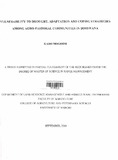| dc.description.abstract | Botswana has experienced droughts in the past, continues to do so and will likely be faced with even more
frequent and intense dry extremes in future. In a semi-arid country whose two thirds are covered by
infertile Kalahari sands and heavily dependent on rain-fed agriculture, this scenario does not bode well for
the rural population with limited livelihood options. This study therefore set out to examine the
vulnerability of arid and semi-arid agro-pastoral communities in Botswana to droughts and their strategies
to cope and adapt against such shocks. A survey of agro-pastoral communities in Kgalagadi North and
Bobonong Sub-districts, coupled with soil analyses was carried out during the 200911 0 season. The
quadrat and transect techniques were used for collecting data on vegetation parameters.
The soils in Kgalagadi North were significantly lower (p<O.05) in P, CEC, OC and Mg than Bobonong
soils-indicating lower fertility. Herbaceous plant cover in Kgalagadi North was higher (p<O.05) than in
Bobonong. The important grass species with regard to livestock were Eragrostis spp., Digitaria spp.,
Urochloa spp. and Stipagrostis uniplumis. The total densities for woody species in Bobonong and
Kgalagadi North study sites averaged 790 and 345 plants per hectare respectively, which was significantly
different (p<0.05). The main woody species in Bobonong were Grewia species (28.89%),
Colophospermum mopane (22.78%), Acacia torti/is (13.33%), Combretum apiculatum (7.78%),
Dichrostachys cineria (7.22%) and Commiphora species (5.56%). In Kgalagadi North study site, Grewia
species (37.22%, especially G. jl.ava), Acacia mellifera (19.44%), Terminalia sericea (10.56%), Acacia
erioloba (10.00%), Acacia luederitzii (8.33%) and Boscia albitrunca (7.22%) dominated.
Drought affected agro-pastoralists in different ways. In Bobonong Sub-district, some of the high ranking
effects included livestock deaths (40%), reduced crop yields (38%), low pasture production (25%) and
increased distances travelled by livestock to water points (12%). The same negative effects were advanced
by farmers in Kgalagadi-with 34% and 25% mentioning increased livestock mortalities and low pasture
quality and quantity, respectively. Low crop production (21%) and long distances treking livestock to
water points (12%) were also singled out.
To cope and adapt to droughts, 15% of the households in Bobonong area enroled in the governmnent's
Labour Intensive Public Works Programme, while 13% harvested larvae of Imbrasia belina moth (locally
known as phane) for consumption and/or sale. Another 11% sought alternative sources of income during
droughts. Other strategies included storage of crop harvests from previous seasons (8%), supplementary
feeding of livestock (8%), planting of drought tolerant crops (7%) and moving stock to better pastures
x
within the communal area (6%). In contrast, Kgalagadi North farmers supplemented their livestock (22%),
provided water for livestock (17%) and sold their animals (17%) to cope with droughts. Other strategies
included moving livestock to better pastures (13%), joining the government's Labor Intensive Public
Works Programme (7%) while even less tried seeking an alternative source of income outside agriculture
(6%). So no one coping or adaptation strategy totally dominated in either study area. This 'fluidity' and
flexibility is key to managing the harsh and unpredictable climate that the farmers operate under.
But despite their efforts to cope and adapt, farmers still experienced some constraints in fully ameliorating
the adverse impacts of droughts. In Bobonong area for example, the top-ranked constraints were
persistence of droughts, lack of diversified sources of income, limited alternative options and wildlife
(especially elephants) damaging crops. In the Kgalagadi North Sub-district, constraints included lack of
water or its poor quality (high salinity), followed closely by lack of diversified sources of income,
persistence of drought and lastly the land tenure system currently in place. These constraints may act
solely or in combination to leave the households vulnerable to drought.
Vulnerability of households to drought varied between the two Sub-districts. In Bobonong, the majority of
households (68%) were highly vulnerable compared to only 16% in Kgalagadi. A number of key
determinants of vulnerability were identified. In Bobonong Sub-district, vulnerability to drought was
significantly (p<O.05) higher among female-headed households, households with less arable land, less
crop yield and among those planting less diversity of drought-tolerant crop varieties. In Kgalagadi North
the size of arable land available for farming per household and the actions taken by households to buffer
upcoming droughts had a significant (p<O.05) and positive relationship to household vulnerability to
drought.
In conclusion, subsistence agro-pastoralists in semi-arid Botswana are affected negatively by droughts,
and employ a myriad of coping and adaptation strategies in response. This wealth of indigenous
knowledge can be strengthened to increase resilience households to lurking climatic shocks like drought. | en |

